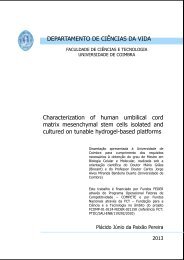role of th1 and th17 cd4+ t cell subsets in the pathogenesis of ...
role of th1 and th17 cd4+ t cell subsets in the pathogenesis of ...
role of th1 and th17 cd4+ t cell subsets in the pathogenesis of ...
Create successful ePaper yourself
Turn your PDF publications into a flip-book with our unique Google optimized e-Paper software.
studies between MS susceptibility <strong>and</strong> <strong>the</strong> MHC class II region. The development <strong>of</strong><br />
“humanized mice”, <strong>in</strong> which <strong>the</strong> animals express transgenes derived from MS patients,<br />
has helped better underst<strong>and</strong><strong>in</strong>g <strong>of</strong> <strong>the</strong> effects <strong>of</strong> <strong>in</strong>dividual genetic variations on<br />
disease development. For example, mice eng<strong>in</strong>eered to express both <strong>the</strong> HLA‐<br />
DRB1*1501 allele <strong>and</strong> a human TCR that recognizes MBP peptide 85‐99 <strong>in</strong> <strong>the</strong> context<br />
<strong>of</strong> HLA‐DR2b were found to spontaneously develop MS‐like disease (Madsen et al.,<br />
1999).<br />
The importance <strong>of</strong> CD4 + helper T <strong>cell</strong>s <strong>in</strong> EAE is <strong>the</strong> ma<strong>in</strong> topic <strong>of</strong> this <strong>the</strong>sis <strong>and</strong> will be<br />
addressed <strong>in</strong> more detail <strong>in</strong> fur<strong>the</strong>r sections.<br />
26<br />
1.3.2 CD4 + REGULATORY T CELLS<br />
Regulatory CD4 + T <strong>cell</strong>s (Tregs) were described for <strong>the</strong> first time some years ago <strong>and</strong><br />
were def<strong>in</strong>ed as an <strong>in</strong>dependent T <strong>cell</strong> population, derived from a naïve precursor <strong>and</strong><br />
capable <strong>of</strong> suppress<strong>in</strong>g <strong>the</strong> function <strong>of</strong> o<strong>the</strong>r T <strong>cell</strong>s. These <strong>cell</strong>s express <strong>the</strong> CD25<br />
marker, <strong>the</strong> alpha cha<strong>in</strong> <strong>of</strong> <strong>the</strong> IL‐2 receptor as found later, <strong>and</strong> <strong>the</strong>ir development <strong>and</strong><br />
function is dependent on <strong>the</strong> transcription factor forkhead box P3 (Foxp3). Foxp3 + Tregs<br />
derived from <strong>the</strong> thymus are denom<strong>in</strong>ated as naturally occurr<strong>in</strong>g Tregs (nTregs).<br />
Alternatively, <strong>the</strong>y can be differentiated from naïve CD4 + T <strong>cell</strong> precursors, <strong>the</strong> <strong>in</strong>duced<br />
Tregs (iTregs). These <strong>cell</strong>s produce high amounts <strong>of</strong> TGFβ, an anti‐<strong>in</strong>flammatory<br />
cytok<strong>in</strong>e. Mice mutant <strong>in</strong> Foxp3, termed scurfy mice, develop lethal autoimmune<br />
syndrome, resultant from deficiency <strong>of</strong> CD4+CD25+ regulatory T <strong>cell</strong>s (Fontenot et al.,<br />
2003). Foxp3 + Tregs have been shown to play a <strong>role</strong> <strong>in</strong> <strong>the</strong> resolution <strong>of</strong> <strong>in</strong>flammatory<br />
immune responses, <strong>and</strong> <strong>the</strong>refore have been suggested as targets <strong>of</strong> a potential<br />
<strong>the</strong>rapeutic target <strong>in</strong> <strong>the</strong> treatment <strong>of</strong> CNS autoimmune disease (Stephens et al., 2009).<br />
Indeed, depletion <strong>of</strong> CD4 + CD25 + Tregs <strong>in</strong>hibited EAE recovery <strong>and</strong> adoptive transfer <strong>of</strong><br />
<strong>the</strong>se <strong>cell</strong>s provided protection (McGeachy et al., 2005). However, <strong>the</strong> mechanisms <strong>of</strong><br />
action <strong>of</strong> Tregs <strong>in</strong> autoimmunity are not well understood <strong>and</strong> <strong>the</strong>re are EAE studies<br />
report<strong>in</strong>g <strong>the</strong> failure <strong>of</strong> Tregs to control <strong>the</strong> auto‐antigenic <strong>in</strong>flammatory responses,<br />
which can doubts <strong>of</strong> <strong>the</strong> possible <strong>in</strong>efficacy <strong>of</strong> treat<strong>in</strong>g autoimmune diseases with Tregs<br />
(Korn et al., 2007b). One possible explanation might be <strong>the</strong> close relationship between

















